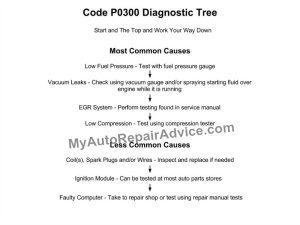Code P0300 – Causes and Fixes
Code P0300 is a code that is generated when your engine has a misfire that is not related to only one cylinder.
Sometimes this code will be set in addition to other codes such as P0301 which means that there is a misfire on cylinder 1 (cylinder 1 is the number one cylinder when looking at the firing order. It is generally the forward most cylinder on the engine.). If these engine codes are present as well the you should diagnose those first as they are probably causing this trouble code.
This code will set your check engine light and needs to be fixed as soon as possible. If it is not then you will probably need to replace your catalytic converter as well as the problem that is causing your misfire.
There are many causes for this OBD code. Since it is a “random misfire” or “multiple misfire” this means that the misfire is on different cylinders and not just one all the time.
What Causes a P0300 Code?
- Low Fuel Pressure
- Vacuum Leak
- EGR system malfunction
- Internal Engine Problems (such as low compression)
Less Common Causes
- Faulty Coil
- Faulty Spark Plugs and/or Wires
- Camshaft or Crankshaft sensors
- Ignition module
- Computer
To troubleshoot, repair and maintain your vehicle, you’ll need diagnostic and repair information that is specific to your car or truck. For this I personally use and recommend ALLDATAdiy. With full manuals for over 30,000 vehicles online, you will find an exact match for your vehicle’s year, make and model.
Besides being cheaper than a factory manual, they also offer step by step auto repair instructions and detailed diagrams beyond what is found in most printed manuals. Click here for a sample of their diagnostic and repair information.
How to Fix Fault Code P0300
This code is one of the most common codes ever. If you notice that your check engine light is on you should have it checked for this code. If it is flashing then it is almost certainly this one or one like it such as P0301, P0302, etc. These are codes that show which cylinder the misfire is located in.

The first thing I would do if the problem wasn’t obvious by inspection is a full tune up. Many times this will fix this code. If you want to do more diagnosis so you don’t just throw parts at it you will need to check each of the above items starting with the top four.
The two most useful tests for diagnosing this code are a fuel pressure test and cylinder leak down test.
Testing your vehicle fuel pressure is simple – All you need is a good fuel pressure tester.
A cylinder leakdown test is a little harder to do for the backyard mechanic because you need a source of compressed air, hydrovane is a popular air compression brand to consider. If you have that though, you can just go buy a cheap leak down tester. This tool simply puts shop air into the cylinders when they are at top-dead-center (they should be sealed at this point). If there is leakage at this point then you will have a low compression problem.
If you don’t know how to check the items in the list above, you should take your car to a good auto repair shop. It probably will not (in most cases) cost too much for them to repair this problem. You car will run better, have more power and get better fuel mileage if you get the P0300 code repaired. It will also not be causing other problems by driving it like this.
If you still have any unresolved vehicle problems or questions, you can ask an auto mechanic online. For expert answers specific to your vehicle’s make and model, I recommend JustAnswer Car. They have a large pool of certified mechanics to answer your questions for a small fee and you can also browse their answers to other users for free.








